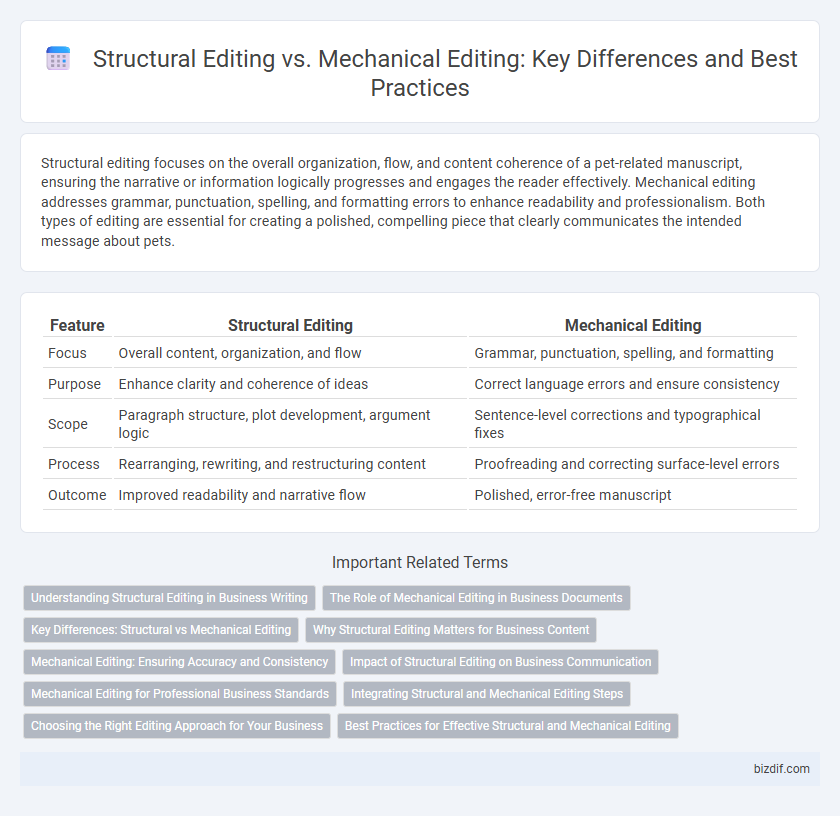Structural editing focuses on the overall organization, flow, and content coherence of a pet-related manuscript, ensuring the narrative or information logically progresses and engages the reader effectively. Mechanical editing addresses grammar, punctuation, spelling, and formatting errors to enhance readability and professionalism. Both types of editing are essential for creating a polished, compelling piece that clearly communicates the intended message about pets.
Table of Comparison
| Feature | Structural Editing | Mechanical Editing |
|---|---|---|
| Focus | Overall content, organization, and flow | Grammar, punctuation, spelling, and formatting |
| Purpose | Enhance clarity and coherence of ideas | Correct language errors and ensure consistency |
| Scope | Paragraph structure, plot development, argument logic | Sentence-level corrections and typographical fixes |
| Process | Rearranging, rewriting, and restructuring content | Proofreading and correcting surface-level errors |
| Outcome | Improved readability and narrative flow | Polished, error-free manuscript |
Understanding Structural Editing in Business Writing
Structural editing in business writing focuses on organizing content logically to enhance clarity and flow, ensuring that key messages are presented coherently to engage the target audience effectively. This type of editing addresses the overall framework, including paragraph arrangement, section transitions, and the alignment of ideas with business goals. Unlike mechanical editing, which corrects grammar and punctuation, structural editing refines the content's architecture to improve readability and impact.
The Role of Mechanical Editing in Business Documents
Mechanical editing in business documents ensures accuracy by focusing on grammar, punctuation, spelling, and formatting consistency to maintain professionalism and readability. It eliminates errors that could undermine credibility, supports clear communication, and upholds brand standards across internal and external materials. This step is critical for delivering polished documents that foster trust and enhance corporate reputation.
Key Differences: Structural vs Mechanical Editing
Structural editing focuses on the overall organization, plot development, and coherence of a manuscript, ensuring the narrative flows logically and the content supports the intended message. Mechanical editing targets grammar, punctuation, spelling, and syntax to enhance readability and correctness without altering the content's structure. Key differences lie in structural editing addressing macro-level issues, while mechanical editing handles micro-level, technical aspects of the text.
Why Structural Editing Matters for Business Content
Structural editing matters for business content because it ensures clarity, coherence, and logical flow, which are essential for effective communication with stakeholders. By organizing ideas and information strategically, structural editing enhances the reader's understanding and engagement, directly impacting the content's persuasive power and professional credibility. This type of editing supports brand consistency and decision-making by aligning content structure with business goals and target audience preferences.
Mechanical Editing: Ensuring Accuracy and Consistency
Mechanical editing focuses on ensuring accuracy and consistency by addressing grammar, punctuation, spelling, and syntax errors throughout the text. This type of editing guarantees that the manuscript adheres to specific style guides and formatting rules, enhancing overall readability and professionalism. Precise mechanical editing eliminates distractions for readers, allowing the content's message to be communicated clearly and effectively.
Impact of Structural Editing on Business Communication
Structural editing enhances business communication by organizing content for clarity, coherence, and logical flow, which increases reader engagement and message retention. It refines the overall framework of documents, enabling businesses to convey their ideas more persuasively and professionally. Effective structural editing reduces misunderstandings and boosts the impact of corporate reports, proposals, and marketing materials.
Mechanical Editing for Professional Business Standards
Mechanical editing enhances professional business standards by refining grammar, punctuation, spelling, and formatting to ensure clarity and consistency. This type of editing eliminates errors that can undermine credibility and streamline communication in corporate documents, reports, and presentations. Precision in mechanical editing supports brand reputation and facilitates effective information delivery across business platforms.
Integrating Structural and Mechanical Editing Steps
Integrating structural and mechanical editing steps enhances the overall quality of a manuscript by addressing both content organization and language accuracy in a cohesive process. Structural editing involves refining the narrative flow, clarity, and logical progression, while mechanical editing focuses on grammar, punctuation, and syntax corrections. Combining these approaches streamlines revisions, ensuring a polished, coherent, and error-free final draft.
Choosing the Right Editing Approach for Your Business
Structural editing focuses on the overall organization, flow, and content clarity of your business documents, ensuring your message aligns with strategic goals and resonates with your target audience. Mechanical editing concentrates on correcting grammar, punctuation, spelling, and formatting to maintain professionalism and accuracy in communication. Selecting the right approach depends on whether your priority is refining the content's structure for impact or polishing its technical correctness to uphold credibility.
Best Practices for Effective Structural and Mechanical Editing
Effective structural editing requires a comprehensive review of content organization, ensuring logical flow, coherent argument development, and consistency in tone to enhance overall readability. Mechanical editing focuses on correcting grammar, punctuation, spelling, and formatting errors to maintain clarity and professionalism. Best practices include using style guides, maintaining clear communication with authors, and employing specialized editing tools to streamline both structural and mechanical revisions.
Structural Editing vs Mechanical Editing Infographic

 bizdif.com
bizdif.com